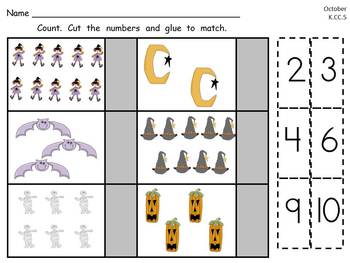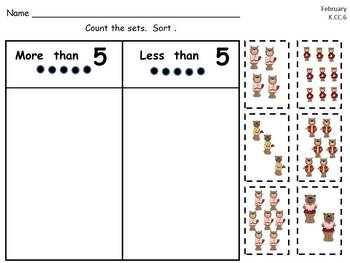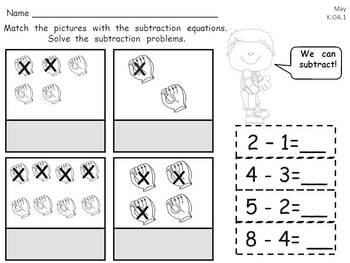Kindergarten Cut and Paste Common Core Math Practice- by Month
Melissa Williams
13k Followers
Grade Levels
K
Subjects
Resource Type
Standards
CCSSK.CC.A.3
CCSSK.CC.B.5
CCSSK.CC.C.6
CCSSK.CC.C.7
CCSSK.MD.A.2
Formats Included
- PDF
Pages
180 pages
Melissa Williams
13k Followers
What educators are saying
Many of my students struggle with any type of writing. Being able to glue the answers down instead of writing makes it easier for me to access their math levels. This was an engaging activity
Description
This packet has 180 cut-and-paste practice pages aligned to the Kindergarten Math Common Core Standards.
The pages are divided by months: there are 20 pages for each month from September through May. For each month, there are 4 different skills/concepts to practice. There are 5 practice pages for each of these skills. These can be using with a skill for each week, or they can be spread out throughout the month, depending on your preference.
September: Matching sets to 5 to the correct numeral, sorting 2-d shapes, counting sets to 5 and sorting by count, ordering numbers 1-5 and 6-10.
October: Matching sets of 1-10 Halloween objects to the correct numeral, matching addition sentences to a Halloween picture, counting sets to 10 and sorting by count, ordering numbers 1-5 and 6-10.
November: Matching sets of 1-10 Veterans’ Day and Thanksgiving objects to the correct numeral, matching addition sentences to a Veterans’ Day or Thanksgiving picture, counting sets 11-20 and sorting by count, finding the missing number.
December: Matching sets 0-15 to the correct numeral, matching addition sentences to a Christmas picture, sorting sets of Christmas objects by more than/less than a given number, finding the missing number.
January: Matching sets 0-20 to the correct numeral, matching addition sentences to a winter picture, matching equal sets of winter objects, sorting based on measurable attributes (length, weight, height, temperature, capacity)
February: Different ways to make a number, matching subtraction sentences to a Valentine’s Day picture, sorting sets of objects by more than/less than a given number, comparing numbers- more than, less than
March- Solving addition sentences and sorting by sum, matching subtraction sentences to a St. Patrick’s Day picture, sorting 3-d shapes, matching sums to addition sentences
April- Finding the number to add to make 10, solving and matching subtraction sentences to a Spring picture, matching differences to subtraction sentences, solving subtraction sentences and sorting by difference
May- Decomposing teen numbers into a ten and some ones, solving and matching subtraction sentences to a baseball picture, sorting flat and solid (2-d and 3-d) shapes, matching answers to addition and subtraction sentences.
I hope you find these activities useful for your classroom. They are ready-to-use pages to teach Common Core Math Standards in your kindergarten classroom.
Thanks for looking and happy teaching!!
The pages are divided by months: there are 20 pages for each month from September through May. For each month, there are 4 different skills/concepts to practice. There are 5 practice pages for each of these skills. These can be using with a skill for each week, or they can be spread out throughout the month, depending on your preference.
September: Matching sets to 5 to the correct numeral, sorting 2-d shapes, counting sets to 5 and sorting by count, ordering numbers 1-5 and 6-10.
October: Matching sets of 1-10 Halloween objects to the correct numeral, matching addition sentences to a Halloween picture, counting sets to 10 and sorting by count, ordering numbers 1-5 and 6-10.
November: Matching sets of 1-10 Veterans’ Day and Thanksgiving objects to the correct numeral, matching addition sentences to a Veterans’ Day or Thanksgiving picture, counting sets 11-20 and sorting by count, finding the missing number.
December: Matching sets 0-15 to the correct numeral, matching addition sentences to a Christmas picture, sorting sets of Christmas objects by more than/less than a given number, finding the missing number.
January: Matching sets 0-20 to the correct numeral, matching addition sentences to a winter picture, matching equal sets of winter objects, sorting based on measurable attributes (length, weight, height, temperature, capacity)
February: Different ways to make a number, matching subtraction sentences to a Valentine’s Day picture, sorting sets of objects by more than/less than a given number, comparing numbers- more than, less than
March- Solving addition sentences and sorting by sum, matching subtraction sentences to a St. Patrick’s Day picture, sorting 3-d shapes, matching sums to addition sentences
April- Finding the number to add to make 10, solving and matching subtraction sentences to a Spring picture, matching differences to subtraction sentences, solving subtraction sentences and sorting by difference
May- Decomposing teen numbers into a ten and some ones, solving and matching subtraction sentences to a baseball picture, sorting flat and solid (2-d and 3-d) shapes, matching answers to addition and subtraction sentences.
I hope you find these activities useful for your classroom. They are ready-to-use pages to teach Common Core Math Standards in your kindergarten classroom.
Thanks for looking and happy teaching!!
Total Pages
180 pages
Answer Key
N/A
Teaching Duration
N/A
Report this resource to TPT
Reported resources will be reviewed by our team. Report this resource to let us know if this resource violates TPT’s content guidelines.
Standards
to see state-specific standards (only available in the US).
CCSSK.CC.A.3
Write numbers from 0 to 20. Represent a number of objects with a written numeral 0-20 (with 0 representing a count of no objects).
CCSSK.CC.B.5
Count to answer “how many?” questions about as many as 20 things arranged in a line, a rectangular array, or a circle, or as many as 10 things in a scattered configuration; given a number from 1-20, count out that many objects.
CCSSK.CC.C.6
Identify whether the number of objects in one group is greater than, less than, or equal to the number of objects in another group, e.g., by using matching and counting strategies.
CCSSK.CC.C.7
Compare two numbers between 1 and 10 presented as written numerals.
CCSSK.MD.A.2
Directly compare two objects with a measurable attribute in common, to see which object has “more of”/“less of” the attribute, and describe the difference. For example, directly compare the heights of two children and describe one child as taller/shorter.





